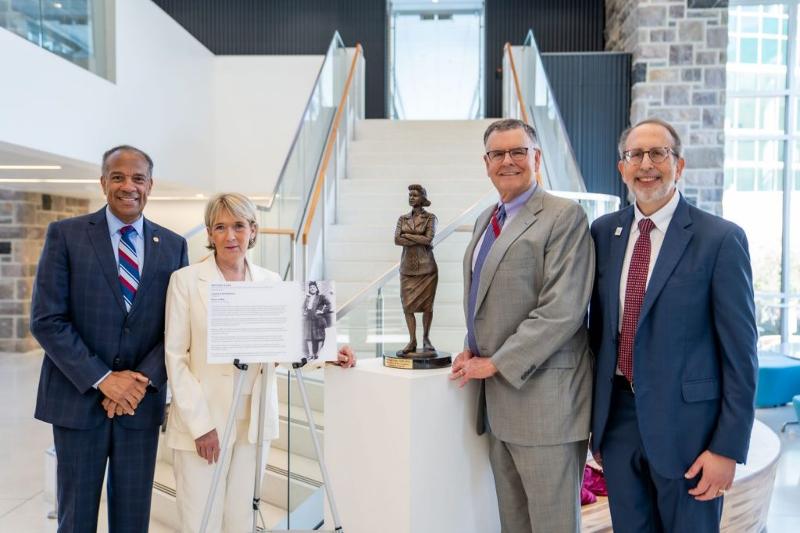In a powerful tribute to Henrietta Lacks, the Fralin Biomedical Research Institute, the Virginia Tech Carilion School of Medicine, and Carilion Clinic have unveiled statues commemorating her groundbreaking contributions to science and medicine. Lacks, a Roanoke native, unknowingly revolutionized medical research with her rare 'immortal' cells. These statues serve as a lasting reminder of her enduring legacy and the impact she has had on the advancement of healthcare. Join us as we delve into the significance of this tribute and the remarkable story of Henrietta Lacks.
Henrietta Lacks: A Medical Pioneer
Explore the remarkable life and contributions of Henrietta Lacks, whose cells have transformed medical research.
Henrietta Lacks, a Roanoke native, made an indelible mark on medical history with her extraordinary cells. Born in 1920, Lacks unknowingly became a medical pioneer when her cervical cancer cells were extracted without her consent during treatment at Johns Hopkins Hospital in 1951. These cells, known as the 'HeLa' cell line, were the first to be successfully cultured and have since been instrumental in countless scientific breakthroughs.
Despite her tragic passing in 1951, Henrietta Lacks' cells continue to thrive in laboratories worldwide, aiding in the development of vaccines, cancer treatments, and more. The unveiling of statues in her honor serves as a testament to her enduring legacy and the impact she has had on the field of medicine.
Honoring Henrietta Lacks' Legacy
Discover the significance of the statues unveiled by the Fralin Biomedical Research Institute, the Virginia Tech Carilion School of Medicine, and Carilion Clinic.
The bronze statues, created by artist Lawrence Reid Bechtel, are a visual representation of Henrietta Lacks' contributions to science and medicine. These maquettes, unveiled at the Fralin Biomedical Research Institute, the Virginia Tech Carilion School of Medicine, and Carilion Clinic, symbolize the importance of recognizing Lacks' impact on medical advancements.
By honoring Henrietta Lacks, these institutions aim to raise awareness about the ethical considerations surrounding medical research and the rights of patients. The statues serve as a reminder to future generations of physicians to provide inclusive and compassionate healthcare for all.
Henrietta Lacks' Enduring Influence
Explore the far-reaching impact of Henrietta Lacks' 'immortal' cells on scientific research and medical breakthroughs.
The HeLa cell line derived from Henrietta Lacks' cells has been instrumental in advancing biomedical research. Since its discovery, these cells have been used in over 110,000 scientific publications, including Nobel Prize-winning research. They have played a crucial role in the development of vaccines, understanding genetic diseases, and testing new drugs.
Henrietta Lacks' cells have not only contributed to scientific progress but have also raised important ethical questions about patient consent and the use of human tissue in research. Her story has prompted discussions and policy changes to ensure patient rights and ethical practices in medical research.
The Collaboration of Institutions
Learn about the partnership between the Fralin Biomedical Research Institute, the Virginia Tech Carilion School of Medicine, and Carilion Clinic in honoring Henrietta Lacks.
The collaboration between the Fralin Biomedical Research Institute, the Virginia Tech Carilion School of Medicine, and Carilion Clinic highlights the shared commitment to recognizing Henrietta Lacks' contributions. These institutions, represented by their respective leaders, joined forces with community support to fund the creation of the statues.
By unveiling the statues in their facilities, the partners aim to educate and inspire future healthcare professionals, emphasizing the importance of patient trust, inclusivity, and ethical research practices.
Conclusion
Henrietta Lacks' impact on medical research and healthcare ethics is immeasurable. Her 'immortal' cells, known as the HeLa cell line, have paved the way for groundbreaking discoveries and advancements in the field of medicine. The unveiling of statues in her honor by the Fralin Biomedical Research Institute, the Virginia Tech Carilion School of Medicine, and Carilion Clinic serves as a lasting tribute to her enduring legacy.
Through these statues, Henrietta Lacks' story will continue to inspire future generations of healthcare professionals to prioritize patient trust, inclusivity, and ethical research practices. Her contributions have not only revolutionized science but have also sparked important conversations about patient rights and the ethical use of human tissue in research.
FQA :
What is the significance of the HeLa cell line?
The HeLa cell line derived from Henrietta Lacks' cells has been instrumental in advancing biomedical research. It has been used in over 110,000 scientific publications and has contributed to important discoveries, including Nobel Prize-winning research.
Why were statues unveiled in Henrietta Lacks' honor?
The statues serve as a tribute to Henrietta Lacks' contributions to science and medicine. They also aim to raise awareness about the ethical considerations surrounding medical research and the rights of patients.
What is the collaboration between the Fralin Biomedical Research Institute, the Virginia Tech Carilion School of Medicine, and Carilion Clinic?
The three institutions collaborated to fund and unveil the statues in their facilities. This partnership highlights their shared commitment to recognizing Henrietta Lacks' contributions and educating future healthcare professionals about patient trust, inclusivity, and ethical research practices.

